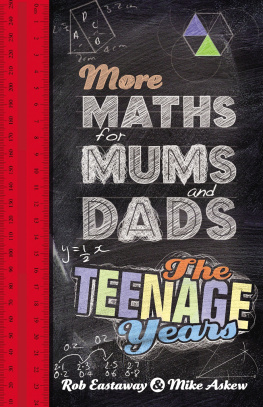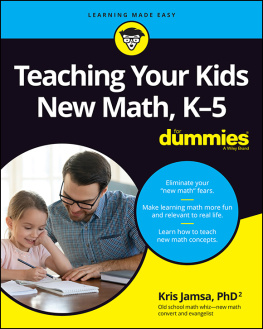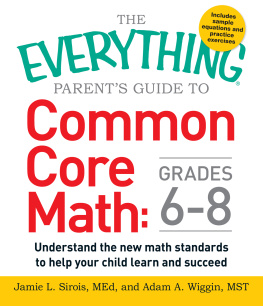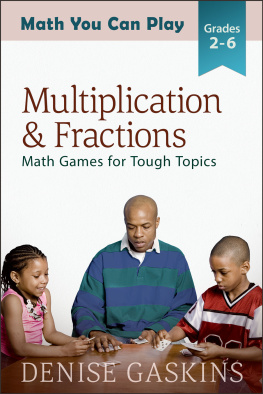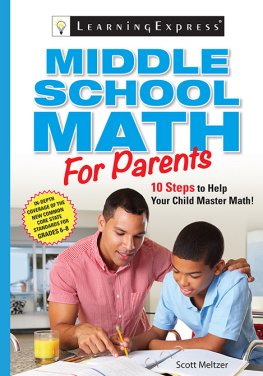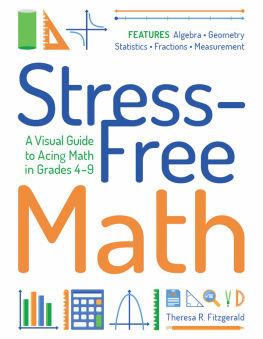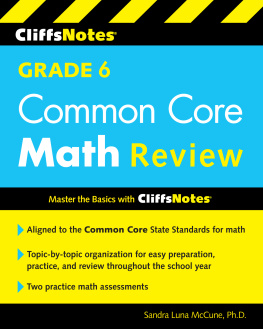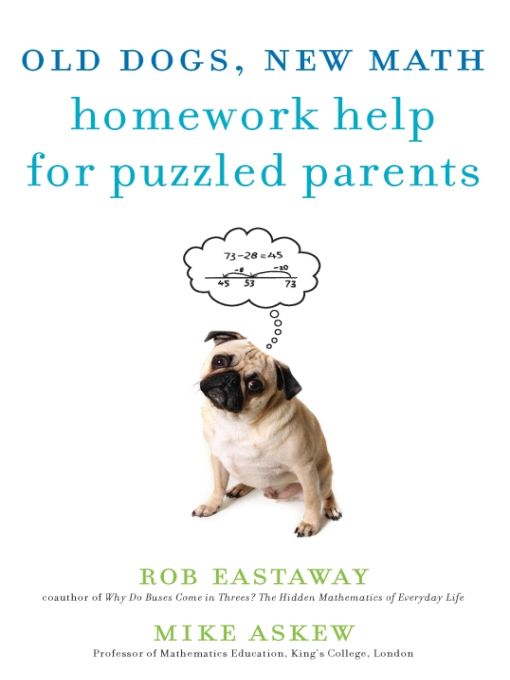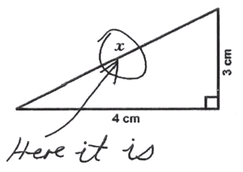Table of Contents
PRAISE FOROLD DOGS, NEW MATH
Sometimes you come across a book which makes you happy. Recently, I did just that... [Old Dogs, New Math] is brilliant, and exactly what far too many parents (including myself) need.
SARAH EBNER, The Times (London)
Rob Eastaway and Mike Askews book is a massive step in making math more fun and comprehensible for moms and dads. It will help to banish the lament that I was never any good at math at school.
SIR PETER WILLIAMS, Chancellor of the University of Leicester
This book is an absolute triumph. Given the authors reputations, I would expect nothing less.
LIZ WOODHAM, Primary Maths Journal
This book will take the terror out of math for all the generations.
JOANNA TROLLOPE, bestselling author of The Other Family
PREPARATION
Q. Find x.
We cant vouch for the authenticity of this famous example of a creative answer to a math question, but all the others that youll find in the book genuinely cropped up in the classroom.
INTRODUCTION
Its the moment that many parents dread: Can you help me with my math homework? Many years, perhaps decades, ago, you went through all this as a child yourself, of course. But it feels very different when youre the one from whom help is being sought. And in any case, things have changed: the math has changed, the methods have changed, and perhaps the attitudes of children to their parents have changed. Thats certainly what parents say, though parents may have been saying this for centuries.
Of all the subjects covered at school, math is the one that worries parents the most. Weve met many a parent whose concern is that their child is beginning to bring home work that the parent cant do. But there are many parents who are at least competent, often very good, at math, and they have a different worry. The problem is: They do it differently at school these days. Attempts by Dad to demonstrate subtraction by adding one and paying ten at the bottom are met by a glazed look from a bewildered child, who finally goes to Mom saying, Dad is just confusing me.
This book is to help you as a parent to reengage with math, to see the subject in a new light, to help you to understand why they do things differently these days (some of it is for very good reasons), and to help you to better understand what is going through your childs head when she or he claims to just not get it. More than anything, our aim is to put a bit more enjoyment into math at homesomething that seems to be in desperately short supply at the moment.
School math is a huge subject, and we couldnt hope to cover it all in a single book. Weve therefore concentrated on the basics, the stuff that children cover (or should cover) in elementary school. We say basic, though much of it is really not that basic at all. In fact, some of the questions that have been posed in tests for eleven-year-olds would tax most adults. But in this book there will be no sines or cosines, no calculus, and absolutely no quadratic equations. Well save those for another day.
THE BIG QUESTIONS
Talking to moms and dads, there are some issues that crop up again and again. Weve called these the Big Questions. We have identified four of them, and they are so important that we have brought them to the front of the book.
1. Why do they do it differently these days?
When their children reach the age of six, many parents get a dreadful shock: They find their children are bringing home vocabulary and methods that they dont recognize. In many households, this introduces a problem. Parents eager to help realize that (a) they dont understand what the child is doing, and therefore dont know if it is right or not, and (b) when they try to demonstrate how to do something, all they manage to do is confuse the child. As a result many parents feel frustrated and helpless.
So what is going on, and, as a parent, what can you do about it?
In most schools, the days are gone when math lessons were endless pages of sums to be done in silence, using techniques for addition and multiplication that dated back hundreds of years. Todays lessons are much more about collaboration and investigation. Long periods of silence are rare, even in math lessons.
The techniques have changed, too. One example of how things have changed is the way that children perform a large multiplication such as 79 43. Most parents were taught the method of long multiplication, and many still use it to do calculations on the back of an envelope. However, there arent many parents who can explain why it works. It is, if you like, a black box for which you turn the handle and the correct answer comes out at the far end (you hope). Today, the emphasis in schools is on teaching methods that help children to understand the underlying math, thus (in theory) reducing the chance of their making mistakes, and building a foundation for understanding more complicated mathematics later on.
This move from learning techniqueslearning howto understanding the math behind themlearning whycame about for several reasons. Firstly, it was realized that there wasnt a halcyon time when everybody left elementary school able to perfectly carry out long multiplication, long division, and so on. Surveys into levels of adult understanding knocked this myth on the head.
Secondly, technology is changing the world we live in at an increasingly rapid rate. Calculators have taken over slide rules and tables of logarithms. The number of times that anyone in their everyday lives actually needs to do a long division or long multiplication has dramatically decreased. But the need for knowledge of when to multiply or divide has increased (Which supermarket offer gives me the best value? Which deal on that car is better?), and we need to be confident that the answers provided by a spreadsheet or calculator are reasonable ones. Today, children are still taught paper-and-pencil techniques but these are closer to back of the envelope methods that confident mathematicians use.
These techniques are not just about getting the right answer (the calculator is far and away the most sensible tool for that) but about helping children develop insight into mathematics, helping them to develop number sense. As one writer, Richard Skemp, puts it, its the difference between providing someone with a list of instructions for getting from A to B and providing them with a map. With a list of instructions, making a mistake can send you down the wrong path and its difficult to get back on track. With a map you can plot your own most sensible route through. Math instruction these days tries to help children develop mathematical maps rather than remember lists of directions.


